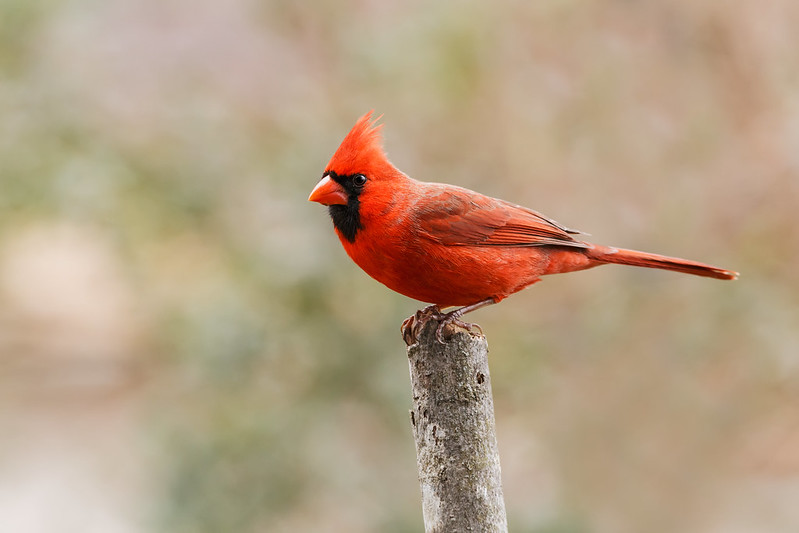Description
One of the most recognizable birds in eastern North America, Northern Cardinals are medium-sized songbirds with large, conical beaks, long tails, and a prominent crest of feathers on their heads.
Northern Cardinals measure 8.3 inches to just over 9 inches long. They weigh around 1.6 ounces.
Males are vibrant red color overall. They have black feathers around their eyes and red-orange beaks, but they are otherwise entirely red.
Females are not as flashy as males, but their pink beaks, red-tipped crests, red tails, and red wings stand out against their brown bodies.
Northern Cardinals that have recently fledged from the nest look somewhat similar to females, but their crests are not fully developed and their beaks are a drab gray color.
Behavior
Northern Cardinals are nonmigratory birds that are fairly social. During the breeding season, individuals tend to only associate with their mate and young, but Northern Cardinals may form sizable groups in the winter months.
This species will form mixed species flocks and forage with other species of birds. Northern Cardinals do not tend to bully smaller species at bird feeders as other, similarly-sized birds may.
Diet
The beaks of Northern Cardinals are perfectly adapted to consume a variety of different seeds, and while seeds make up the majority of a Northern Cardinal’s diet, these birds will also consume insects and berries. Adult Northern Cardinals almost exclusively feed their young insects.
Habitat
Northern Cardinals can be found in any habitat that supports shrubs and small trees. Look for these birds in hedgerows, backyards, parks, and forest edges.
These birds are quite adaptable, being able to survive in suburbs and even big cities.
Range
Northern Cardinals occur in the United States, Mexico, and far southeastern Canada. Small numbers of this species also exist in northern Central America.
In the United States, birders can expect to find this species east of the Great Plains and in the American Southwest. While a warming climate and expanding suburban development are detrimental for most bird species, it has helped Northern Cardinals to expand their range northward.
Breeding
Northern Cardinals are monogamous by nature, with the majority of birds keeping their mate for the entirety of their lives. Mated pairs of Northern Cardinals investigate prospective nest sites together. Once a nest site is selected, the female Northern Cardinal commences building the nest while the male sings and defends the territory.
Nests are often placed in the forks of a shrub or young tree. Northern Cardinals choose to place their nests in plants that provide plenty of cover from potential predators. It takes a female anywhere from 3 to 9 days to construct a nest.
The nests of Northern Cardinals have four distinct layers. The outer layer is constructed using twigs that are covered by leaves—the third layer. Females then add a layer of tree bark and the final, interior layer of soft materials that include various types of grass. The end product is a durable, cup-shaped nest.
Northern Cardinals may produce 1 to 2 broods of eggs per year, with each clutch containing 2 to 5 eggs. It takes just shy of 2 weeks for the eggs to hatch, and the nestlings leave the nest 7 to 13 days later.
Backyard Birding
This species is among the most iconic, recognizable species of backyard birds in the United States. Northern Cardinals will readily visit backyards to feed from bird feeders or bathe in birdbaths. This species will not nest in birdhouses, but landowners can easily entice these birds to nest in their yards by planting shrubs.
Northern Cardinals readily feed from bird feeders where they love consuming sunflower and safflower seeds. They may perch on a bird feeder and feed directly from the structure, but they’re often happier simply feeding on seed that has spilled onto the ground.
Population Status
The population of Northern Cardinals has been steadily rising in the last half-century as this species has expanded its range and established populations within human development. Northern Cardinals have a global population of 130 million birds.


